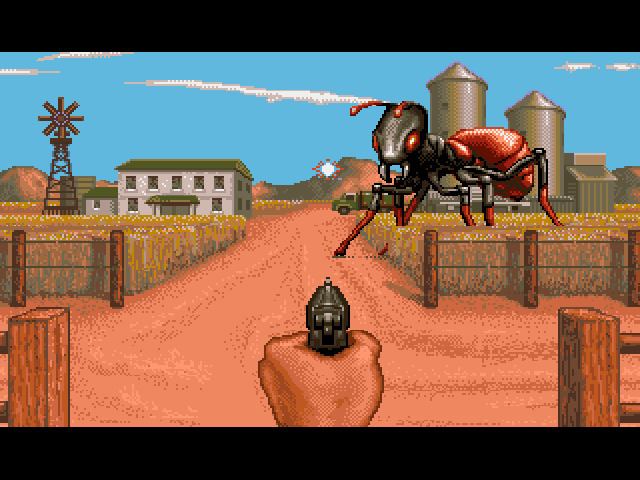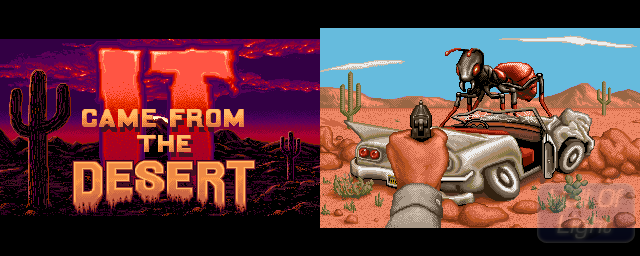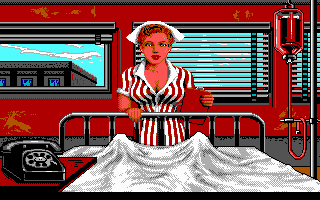9 /10 1 Votes
4.5/5 GamesNostalgia Programmer(s) Randy Platt | 4.5/5 My Abandonware Producer(s) Pat Cook Writer(s) Kenneth Melville Initial release date 1989 | |||||||||||||||||||||||||||||||||
 | ||||||||||||||||||||||||||||||||||
Similar Cinemaware games, Adventure games | ||||||||||||||||||||||||||||||||||
Amiga longplay it came from the desert
It Came from the Desert is a 1989 action-adventure game by Cinemaware. It was originally released for the Amiga, but later ported to MS-DOS, as well as released in distinctly different forms to consoles. The two console versions, for the Sega Genesis/Mega Drive (unreleased) and TurboGrafx-16, are distinctly different from the versions released for computer platforms, in terms of gameplay and presentation. An expansion set Antheads: It Came from the Desert II was released in 1990.
Contents
- Amiga longplay it came from the desert
- Amiga longplay antheads it came from the desert ii
- Premise
- Losing Duration Replays
- Gameplay
- Adventure
- Action
- Weapons and Vehicles
- Good Ending
- Minigames
- Plot
- Release
- TurboGrafx CD
- Expansion set
- Reception
- Trivia Legacy
- Film
- References

Like most of Cinemaware's titles, It Came From the Desert takes its inspiration from Hollywood. This game is inspired by dozens of 1950s "B" movies, especially the 1954 mutant-ant classic Them!. The game is a fairly non-linear combination of dialogue boxes and several types of action scenes, typical of contemporary Cinemaware releases.

Amiga longplay antheads it came from the desert ii
Premise

The player assumes the role of Dr. Greg Bradley who comes to remote Lizard Breath, Nevada on June 1, 1951. As a geologist, he wants to study a recent site of a meteor crash somewhere in the desert south-west of the small town. Early in the game, he learns that the radiation of the meteor has enlarged a local ant population to an enormous size. However, few take his observations seriously. Worried, that the ants will soon mate and spread, he must work against a ticking clock and devise a plan to stop the ants from terrorizing the world. In order to succeed, the player must visit many locations ranging from mines, farms, a pub, an airfield, a local radio station and many more to find evidence of the ants, then convince townsfolk and authorities of impending doom. At the same time the player must contain the ant infestation.

Only in using every resource available, from workers to the tanks and fighter jets of the National Guard, will the player be able to take the fight to the giant ants.
Mechanically, It Came From the Desert can be considered real-time. Waiting, sleeping (at home or in a hospital bed) and driving around consumes time. As it turns out, the player has a fixed amount of in-game days (15 days, ending with June 15) to succeed. If Dr. Bradley fails by this date, the ants will mate and spread, which results in a gloomy ending. To reach a good ending, the player must locate the ant colony and kill the queen ant.
Losing, Duration & Replays
The player must replay the game, and take information into account that was learned in previous games, and then optimize a path (“when to be where”) to stop the ants. Typically, the player cannot win the game in one play-through and a conventional game over doesn’t exist. Instead, when Dr. Bradley gets “killed” he awakes in hospital and time jumps forward as a penalty to reflect the time that has passed spending in bed. Alternatively, the player can try to avoid the penalty by succeeding in a hospital escape minigame, which also acts as a comic relief.
The duration of one play-through can be about one hour. It will vary due to thinking, exploring and time spent with reading, time wasted (“skipped”) from driving around and other factors. The earlier game involves more dialogues and collecting clues, later it is more action-oriented; especially when the player succeeded in convincing the authorities to declare an emergency (possible after about 10 days). Dr. Bradley’s actions and decisions in the dialogues have an influence on the characters, and as a result, on the story, including (at least) two endings.
Gameplay
It Came From the Desert utlilizes different gameplay types, a hallmark of Cinemaware games. An “adventure” mode provides the overall structure and advances the plot. A main “action” mode is used to combat and defeat the ants. A collection of minigames cover special aspects of the narrative.
Adventure
The adventure mode is similar to a visual novel or adventure game (like Phoenix Wright) and provides the overall structure, in which everything else is embedded. Except selecting the location in the overview, the game world is viewed from a first person perspective. It consists of:
As typical for adventure games, progress is complicated by various smaller story arcs which Dr. Bradley can resolve. One of them involves a mysterious “Neptune” secret society and a murder case. There is also a romance plot. The nonlinear narrative comes about as it depends which location Dr. Bradley visits at what time, and whether he meets certain characters and whether he advances their story in time. The plot also involves making decisions which characters to meet, and support.
Action
At certain places or due to events, the game world switches into a top-down perspective and the player assumes control of Dr. Bradley to navigate him around in a finer detail (in the adventure mode he can only drive to a discrete locations shown by name on the overview). The entire game world is reproduced from this perspective, however earlier in the game only a smaller section is visible and relevant.
It is commonly triggered when several ants are approaching, while the player is the “adventure” mode. The player must move Dr. Bradley away and escape from the ants which try to encircle him.
Weapons and Vehicles
Dr. Bradley can throw grenades to defend himself. Later in the game, he has other weapons at his disposal, such as dynamite and a flame thrower. Depending on location, Dr. Bradley can also drive vehicles (such as a tank), fly a plane and spray pesticides and even fly a jet in the emergency phase.
Good Ending
In the later part of the game, the player must locate and descend into the ant colony in order to place an explosive near the queen ant and thereby conclude the story with a “good ending”.
Minigames
Plot
The game is set in 1951. When the rural American town of Lizard Breath, California, witnesses a meteor fall, town geologist and player character Greg Bradley has to discover the source of some strange occurrences. His role as a young man of science in a 1950s movie setting also gives Bradley the ability to operate aircraft, heavy machinery and several types of firearms, and to suffer no injury worse than a flesh wound unless he's committing a heroic sacrifice.
Release
It Came From the Desert was originally released for the Amiga in 1989 and then was ported to several other popular systems of the era. In early 1991, Cinemaware released a version for MS-DOS. The latter was a last attempt of Level 9 Computing to stay in business, still the firm closed in June of that year. These versions were, apart from minor palette differences, identical to the original.
A Sega Genesis/Mega Drive version was to be released in 1990, but was cancelled. It is an overhead shooter with the main protagonist running around on foot, although it features more free roaming gameplay than traditional scrolling shooters. Among the differences in play mechanics, the Sega version allowed the player to create powerups that were fashioned by collecting machinery pieces and joining them together in different combinations. The storyline also differs from the game, instead casting the player not as the scientist from the original but as a teenage pest control worker known as Buzz who makes a variety of improvisational weapons with various materials combined with his pest control equipment. Although the Sega version was never actually offered for sale, it was distributed as a ROM image (for use with console emulators) from the Cinemaware website after the turn of the 21st century. Despite the similarity of camera perspective, the Sega version did not appear to reuse any of the graphical elements created for use in the computer-based versions. In 2014 Cinemaware teamed up with Pier Solar developer WaterMelon to develop a cartridge version called Extended Cut with new cutscenes, endings, a new intro sequence and "additional gameplay elements". As of April 2016, the game still has not been released.
The game and its expansion were released on Steam as part of a Cinemaware Anthology collection.
TurboGrafx-CD
The TurboGrafx-CD version was released in 1991. It is a CD-ROM based game that makes use of full motion video with recorded sequences of live actors. There are also action sequences that use drawn graphical elements (not captured, as seen in games such as Mean Streets by Access Software). The side-scrolling action sequence consists of the player battling ants in tunnels. The TurboGrafx-CD version did reuse the graphical elements from the computer version for the overhead battle sequences, but not for any of the character conversation segments. The storyline and characters were dramatically changed; the player character is no longer a spry scientist from the city visiting the countryside, but a local teenage biker punk named Buzz Lincoln who is somehow immune to the ant queen's mind control and begins a nearly hopeless counterattack against her hordes.
Expansion set
It Came From the Desert was followed by an expansion pack called Antheads: It Came from the Desert II in 1990. Antheads was made available in the United States through mail order directly from Cinemaware, and on store shelves in Europe. Antheads is not a standalone game; it requires ownership of the original chapter in order to play.
The story of the game takes place 5 years after the previous and expands on the possible second Ant Queen mentioned in the first game's ending. The protagonist is an Army officer named Brick, who has stolen a detonator for an atomic bomb as his kid brother is a tester for the weapon and fears that the Army's then-ignorance of radiation will cause his brother and other testers to die. Brick tries to find Dr. Wells who has since died and is ambushed by surviving soldier ants who steal the detonator to rouse their dormant second queen. Brick must find Dr. Wells' notes that prove radiation is fatal as well as help the town fend off the new ant army.
Reception
Computer Gaming World called It Came from the Desert "one of the most enjoyable programs yet to emerge from Cinemaware ... a very playable and compelling game with many enjoyable hours to be experienced". Antheads won game of the year honors from Computer & Video Games magazine.
Trivia & Legacy
Film
Cinemaware and Roger! Pictures started in 2015 to create the film version of the game. The film will be directed by Marko Mäkilaakso.
